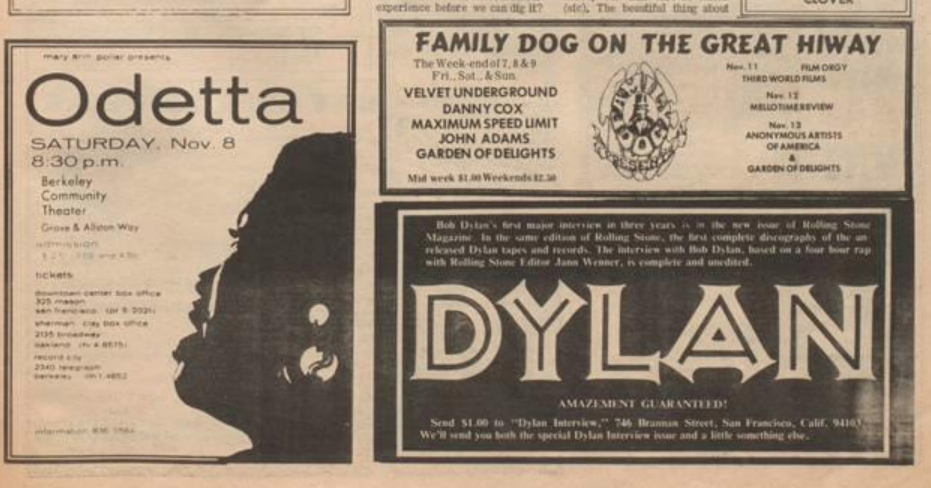When many people think of American folk music, some of the first musicians that comes to mind are Bob Dylan, Pete Seeger or Woody Guthrie. Few people know of Odetta Holmes, known simply by her stage name Odetta. Her name isn’t even mentioned in the Wikipedia “American Folk Music” page! Most people know her as “The Voice of the Civil Rights Movement,” due to her influential role she played as an activist and blues/gospel musician.
However, Odetta started off not as a folk singer, but instead earned a music degree at Los Angeles City College. She went on to tour with a musical theater group performing “Finian’s Rainbow,” which was, fittingly, about prejudice. As she toured, she discovered that enjoyed singing in the coffeeshops late at night, infusing her music with the frustration she experienced growing up. In a 2005 National Public Radio interview, she said: ”School taught me how to count and taught me how to put a sentence together. But as far as the human spirit goes, I learned through folk music” [2].
Odetta released her first solo album, “Odetta Sings Ballad and Blues,” in 1956. This album would turn out to be influential for a certain Bob Dylan. He stated in a 1978 Playboy interview that “the first thing that turned me on to folk singing was Odetta,” after listening to this album in a record store. He learned all the songs and found something “vital and personal” in her singing [4]. Not only did her music draw Bob Dylan to folk music, but she also met Joan Baez, another popular folk musician, and Baez cites Odetta as one of her primary influences as well [5]. Two of the biggest names in American folk music were influenced by a woman and social activist that would later go on to perform at the 1963 march on Washington, march with Martin Luther King Jr. from Selma to Montgomery in 1965, sing for presidents Kennedy and Clinton, as well as perform at New York’s Carnegie Hall.
I think that’s pretty neat
https://www.youtube.com/watch?v=Fd-ccVrIbQI
Odetta singing Muleskinner Blues, 1956
Bob Dylan Singing Muleskinner Blues, 1962
1.”Photo Standalone 23 — no Title.” The Chicago Defender (National Edition) (1921-1967), Jan 25, 1964. 10, http://search.proquest.com/docview/493137885?accountid=351.
2. Weiner, Tim. “Odetta, Voice of Civil Rights Movement, Dies at 77.” NYTimes.com. http://www.nytimes.com/2008/12/03/arts/music/03odetta.html?pagewanted=all&_r=0 (Accessed March 9, 2015)
3. “Odetta Sings Ballads and Blues, Expanded CD Cover.” 1956. wikipedia.org.
4.”Playboy Interview: Bob Dylan.” http://www.interferenza.com/bcs/interw/play78.htm (Accessed March 9, 2015)
5. Baez, Joan. And a Voice to Sing With: A Memoir. New York: Simon & Schuster, 2009, p. 43.
6.”No Title.” Berkeley Tribe (1969-1972), 1969. 22-23, http://www.rockandroll.amdigital.co.uk/Search/DocumentDetailsSearch.aspx?documentid=1065486&prevPos=1065486&vpath=searchresults&pi=1




Donny, you picked an exciting subject for this blog post. Learning more about the lineage of folk music (especially well-known and commercially successful figures) was eye-opening, especially because we don’t go as far back as we should. It would be interesting to compare Dylan’s cover with Odetta’s recording as an illustration of how folk music was changed with each cover. Are there any songs you could find that haven’t been covered, and are any of them original? Great primary sources, and great job!
Donny, wonderful job writing about Odetta Holmes. I had never heard of her before reading your blog post, and I find her to be fascinating. The influence she left on the great folk revivalists like Bob Dylan and Joan Baez is something that is very important, and yet it seems that music historians have passed over Holmes… like so many important women musicians over centuries. She was clearly a bold figure in history, having performed at Carnegie Hall as well as participated in the march from Selma to Montgomery with MLK Jr. Thank you for shedding light on someone who I had never heard of, but who is very important to American history.